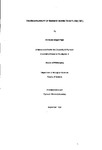THE BIOAVAILABILITY OF SEDIMENT BOUND TRIBUTYLTIN (TBT)
| dc.contributor.author | Dingle Pope, Nicholas | |
| dc.contributor.other | School of Biological and Marine Sciences | en_US |
| dc.date.accessioned | 2013-11-05T13:15:24Z | |
| dc.date.available | 2013-11-05T13:15:24Z | |
| dc.date.issued | 1998 | |
| dc.identifier | NOT AVAILABLE | en_US |
| dc.identifier.uri | http://hdl.handle.net/10026.1/2606 | |
| dc.description | Merged with duplicate record 10026.1/591 on 12.04.2017 by CS (TIS) | |
| dc.description.abstract |
Tributyltin is arguably the most toxic compound ever to be deliberately introduced into the marine environment as an ingredient of antifouling paints. It has had widespread toxic effects on a range of marine organisms, with some gastropod species being particularly sensitive. Effects of TBT on non-target species have resulted in partial bans on its use in many countries, so that new inputs to the water column have decreased in most areas. One of the physicochemical features of TBT is that it is readily sequestered by suspended particulates due to its low solubility and its hydrophobicity, therefore becoming incorporated into estuarine sediments. The availability of this sediment-bound TBT has been investigated through its potential for re-release back to the water column, and directly from the sediment using the sediment dwelling gastropod Hinia reticulata. The sorption process itself has been investigated using natural components to determine the sediment-water partition coefficient (Kd) together with factors affecting its magnitude. Sorption by sediments has been shown to be rapid (minutes), although the achievement of equilibrium may take longer (hours), and exhibits a Freundlich-like dependence on the TBT concentration due to the variable energies of TBT sorption sites on sediment particles. The major determinant of Kd is sediment type, greater adsorption occurring in fine-grained organic rich sediments compared to low organic sands; although both salinity and pH modify the degree of adsorption. The sorption process has been shown to be reversible, so that previously contaminated sediments may act as reservoirs of TBT, releasing the compound back to the overlying water for many years. Hinia reticulata has been shown to be an effective and quantitative accumulator of both dissolved and sediment-bound TBT, principally acquiring TBT from water across the respiratory surfaces. When additionally exposed to sediments, significantly higher body burdens were accumulated, with up to 80% of the total attributable to the sediment. Uptake of TBT across the surface of the head/foot appears to be an important pathway for sediment-exposed Hinia reticulata, while the ingestion of contaminated sediment does not appear to occur. Hinia reticulata is capable of metabolising TBT to lesser butylated and presumably less toxic products which are excreted, making its accumulated body burdens responsive to changing environmental TBT levels, and increasing its value as a biomonitor. When exposed to a range of TBT contaminated sediments, Hinia reticulata showed there to be greater TBT availability from sediments with a low sorptive capacity (sands), principally through desorption of TBT to the overlying water. Fine-grained organic-rich muds, which have a greater capacity for TBT, produced lower accumulated burdens in Hinia reticulata, but may represent more important long-term sources of TBT to benthic organisms in estuaries. | en_US |
| dc.description.sponsorship | Plymouth Marine Laboratory | en_US |
| dc.language.iso | en | en_US |
| dc.publisher | University of Plymouth | en_US |
| dc.title | THE BIOAVAILABILITY OF SEDIMENT BOUND TRIBUTYLTIN (TBT) | en_US |
| dc.type | Thesis | |
| plymouth.version | Full version: final and full version as approved by the examiners at the time of the award of your degree | en_US |
| dc.identifier.doi | http://dx.doi.org/10.24382/3370 | |
| dc.identifier.doi | http://dx.doi.org/10.24382/3370 |
Files in this item
This item appears in the following Collection(s)
-
01 Research Theses Main Collection
Research Theses Main


